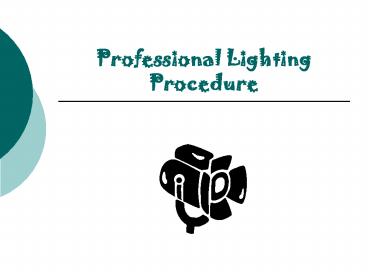Professional Lighting Procedure - PowerPoint PPT Presentation
1 / 21
Title:
Professional Lighting Procedure
Description:
... a focus session the lighting designer will check for the first time if he has ... the final print out should be ready prior to the production ... – PowerPoint PPT presentation
Number of Views:82
Avg rating:3.0/5.0
Title: Professional Lighting Procedure
1
Professional Lighting Procedure
2
Design Responsibility
- Producer/Director
- Director works under restrictions of producer
- Designers (costume, lighting, sound)
- Selected by director
- Lighting Designer
- Prepare lighting design (lights and special
effects) consisting of drawings and schedules - Head Electrician
- Supervises lighting crews for set and run of
production
3
Design Responsibility cont.
- Production Electrician
- Facilitates lighting set up, assists with light
ordering and coordinates crews and budgets - Lighting Crew
- Install, hang cable and plug lighting equipment,
responsible for adjustments and aiming fixtures - Running Crew
- Responsible for nightly operation (follow spots,
special effects)
4
Design Procedure
- Script Analysis
- Talk w/ Director
- Set Costume Design
- Study the Theatre
- Time/Crew/Budget
- Attend Rehearsals
- Prepare the Lighting Design
- Supervise the Focus Level Setting
- Lighting Rehearsals
5
Design Concept
- Statements of designers hopes
- Concept should be fundamental
- Based on emotional qualities indicated in the
script - Provides justification and direction for all
decisions
6
Design Communications
- Communication
- Visualize, Verbalize, Document, Direct
- Drawings
- Produce lighting plot-lighting fixtures,
locations, and relation to stage (easy to use) - Schedules
- Set up and daily maintenance, anything not
clearly shown on light plot
7
Design Planning
- Understand theatre and set design (visualize)
- Understand scale, distance and angles
- Utilize set plans, 3-D models, and possible
computer designs
8
The Lighting Section
- Cross-Section
- Drawn as a slice
- Sections stage floor, house, ceiling, scenery
etc. - Allows lighting designer to accurately measure
throw distances
9
The Lighting Plot"If it ain't on the page, It
ain't on the stage"
- physical design drawn
- Labels exact locations and stage relation of
lights - Must clearly communicate to others
10
The Hook Up
- a numerical list of all channels used in a
particular production. - A typical hook-up will show the channel number,
dimmer number, circuit number, or fixture number
11
Scale Sizes
- May require 12-24 dimmers up to 24 channels or
controls - May require more than 500 dimmers to 300 control
channels
12
INSTRUMENT SCHEDULE
- The instrument schedule is a detailed list of all
fixtures on a light plot. - It allows the Head Electrician to rapidly
identify all the details, for any fixture.
13
Fixture
- Each fixture is normally given a number
- Example-
- 1 Bridge-5, 1 Pipe-12, 1Boom-8
Fixtures are in order just as the positions are
in a typical order From stage left to stage
right From top to bottom From down stage to up
stage
14
The Positions
- The positions are normally in order
- From curtain line to rear of auditorium
- From curtain line to rear of stage
- Booms
- Floor positions
- Special effect equipment
15
The Magic Sheet
- It consist mainly of a single piece of paper
- The paper is about 8.5 x 14 and divided into
about 15 squares - Each square represents a visual group of
fixtures. - The number of arrows indicate the number of
fixtures and the direction of the light. - The designer stands on the stage and asks for
which channel number he wants to be active. - A crew member will be directed on how to aim the
fixture.
16
The Focus Session
- In a focus session the lighting designer will
check for the first time if he has the right
equipment and positions - The crew and light designer work in a darkened
theatre - An electrician will operate and work the lights
from the stage or control booth.
17
The Level Session
- When all the fixtures have been given to the
dimmers and focused the designer lighting
pictures called level or cue setting session. - Sometimes the lighting designer may only have up
to 4-8 hours to set all the lighting cues for the
production. - The designer will work with all the lighting
going up or down and when he is done and will
seek approval from the director. - Last, everything is given a cue number
18
Proving that the Lights are Right
- The lighting designer has to show that he has the
expected lighting. - Even though some things may be missing from the
stage settings. - Like, props, furniture, carpets or curtains.
- Missing objects can make the lighting designers
job more difficult.
19
The Cue Sheet
- This is a written documentation or each lighting
cue - Each cue is given a number and time and is
clearly written down - The cue sheet is needed to 2 reasons
- if the lighting control board is a manual system
which means with no electronic memory, it is the
only record of the lighting. - Even if the lighting control board has an
electronic memory, a written record of each
lighting cue is kept for safty reasons.
20
Print Outs
- Since systems come with a printer each cue can be
recorded and printed at the same time. - In rehearsals the designer might ask for
printouts of all the cues - the final print out should be ready prior to the
production - The designer and direct should have a copy of the
print out also.
21
PICTURE
- THIS IS JUST A PICTURE I THOUGHT WAS TYTE































